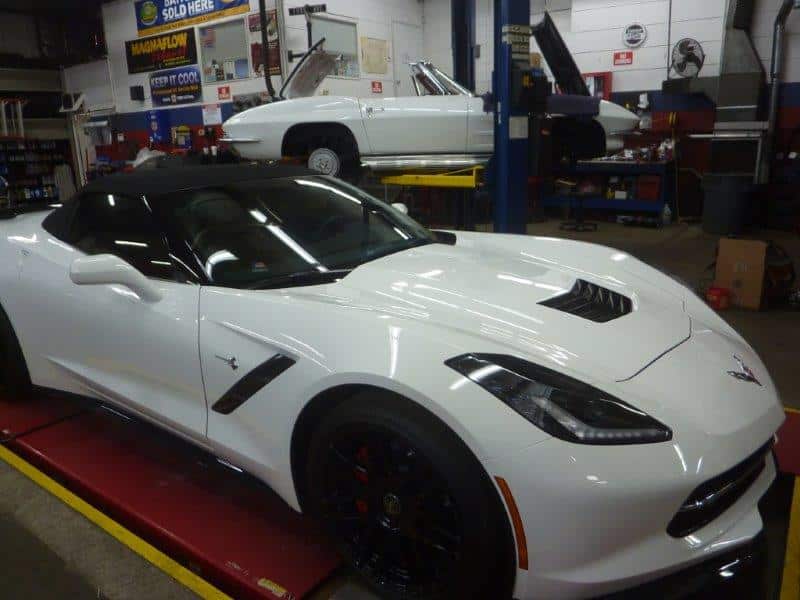Chevrolet Corvettes – 50 Years of difference
All of us at JD’s found this shot to be pretty cool!!!
- 50 years of difference!!
- 1964 Chevrolet Corvette
- 2014 Chevrolet Corvette
History of the 2 shown here
The Chevrolet Corvette is a sports car manufactured by the Chevrolet division of American automotive conglomerate General Motors (GM). The car has been produced through seven generations.The first model, a convertible, was designed by Harley Earl and introduced at the GM Motorama in 1953 as a concept show car. Myron Scott is credited for naming the car after the type of small, maneuverable warship called a corvette.Originally built in Flint, Michigan and St. Louis, Missouri, the Corvette is currently manufactured in Bowling Green, Kentucky and is the official sports car of the Commonwealth of Kentucky.
A Corvette has been used as the Indianapolis 500 pace car 12 times.
Second generation-C2 (1963–1967)
1963 Corvette Sting Ray Coupe
The second generation (C2) Corvette, which introduced Sting Ray to the model, continued with fiberglass body panels, and overall, was smaller than the first generation. The C2 was later referred to as mid-years. The car was designed by Larry Shinoda with major inspiration from a previous concept design called the “Q Corvette,” which was created by Peter Brock and Chuck Pohlmann under the styling direction of Bill Mitchell. Earlier, Mitchell had sponsored a car known as the “Mitchell Sting Ray” in 1959 because Chevrolet no longer participated in factory racing. This vehicle had the largest impact on the styling of this generation, although it had no top and did not give away what the final version of the C2 would look like. The third inspiration was a Mako Shark Mitchell had caught while deep-sea fishing.
Production started for the 1963 model year and ended in 1967. Introducing a new name, “Sting Ray”, the 1963 model was the first year for a Corvette coupé and it featured a distinctive tapering rear deck (a feature that later reappeared on the 1971 “Boattail” Buick Riviera) with, for 1963 only, a split rear window. The Sting Ray featured hidden headlamps, non-functional hood vents, and an independent rear suspension. Corvette chief engineer Zora Arkus-Duntov never liked the split rear window because it blocked rear vision, but Mitchell thought it to be a key part of the entire design. Maximum power for 1963 was 360 bhp (270 kW) and was raised to 375 bhp (280 kW) in 1964. Options included electronic ignition, the breakerless magnetic pulse-triggered Delcotronic first offered on some 1963 Pontiac models.On 1964 models the decorative hood vents were eliminated and Duntov, the Corvette’s chief engineer, got his way with the split rear window changed to a full width window.
1965 Corvette Sting Ray Coupe
Four-wheel disc brakes were introduced in 1965, as was a “big block” engine option: the 396 cu in (6.49 L) V8. Side exhaust pipes were also optionally available in 1965, and continued to be offered through 1967. The introduction of the 425 bhp (317 kW) 396 cu in (6.49 L) big block in 1965 spelled the beginning of the end for the Rochester fuel injection system. The 396 cu in (6.49 L) option cost US$292.70 while the fuel injected 327 cu in (5.36 L) engine cost US$538.00. Few people could justify spending US$245.00 more for 50 bhp (37 kW) less, even though FI could deliver over 20 mpg on the highway and would keep delivering fuel despite high G-loading in corners taken at racing speeds. Another rare ’63 and ’64 option was the Z06 competition package, which offered stiffer suspension, bigger, multi-segment lined brakes with finned drums and more, only a couple hundred coupes and ONE convertible were factory-equipped this way in 1963. With only 771 fuel-injected cars built in 1965, Chevrolet discontinued the option at the end of the ’65 production, having introduced a less-expensive big block 396 engine rated at 425 hp in the middle of the production year and selling over 2,000 in just a few months. For 1966, Chevrolet introduced an even larger 427 cu in (7.00 L) Big Block version. Other options available on the C2 included the Wonderbar auto-tuning AM radio, AM-FM radio (mid-1963), air conditioning (late-1963), a telescopic steering wheel (1965), and headrests (1966). The Sting Ray’s independent rear suspension was successfully adapted for the new-for-1965 Chevrolet Corvair, which solved the quirky handling problems of that unique rear-engine compact.[26]
1967 Corvette Sting Ray Convertible
1967 was the final year for the C2 generation. The 1967 model featured restyled fender vents, less ornamentation, and back-up lamps which were now rectangular and centrally located. The first use of all four taillights in red also occurred in the 1967 model; this all-four red taillight treatment continued on the first C3 in 1968 only and later returned on the first C4 in 1984, continuing on all Corvettes since. 1967 had the first L88 engine option which was rated at 430 bhp (320 kW), but unofficial estimates place the actual output at 560 bhp (420 kW) or more. Only twenty such engines were installed at the factory. From 1967 (to 1969), the Holley triple two-barrel carburetor, or Tri-Power, was available on the 427 L89 (a $368 option, on top of the cost for the high-performance 427).Despite these changes, sales slipped over 15%, to 22,940 (8,504 coupes, off close to 15%, and 14,436 convertibles, down nearly 19%).
Duntov came up with a lightweight version of the C2 in 1962. Concerned about Ford and what they were doing with the Shelby Cobra, GM planned to manufacture 100 Grand Sport Corvettes, but only five were actually built. They were driven by historic drivers such as Roger Penske, A. J. Foyt, Jim Hall, and Dick Guldstrand among others. Today the five cars (001-005) are all held by private owners, and are among the most coveted and valuable Corvettes ever built. 002 is exhibited in the Simeone Foundation Automotive Museum and is in running condition.
Seventh generation-C7 (2014–)
2014 Corvette Stingray Coupe
2014 Corvette Stingray convertible
The next-generation (C7) Corvette had been in development since 2007. Originally set to be introduced for the 2011 model year, its introduction was delayed for 3 years. It was finally released for the 2014 model year. Mid-engine and rear-engine layouts had been considered, but the front-engine, rear-wheel drive (RWD) platform was chosen to keep production costs lower.
To GM’s product planners and marketers, the fact that the Corvette had become known as an “old man’s toy” became a prime factor in developing the next generation. Studies showed that about 46 percent of Corvette buyers in 2012, through October, were 55 or older, compared with 22 percent of Audi R8 and 30 percent of Porsche 911 customers. The head of Chevy marketing, Chris Perry, acknowledges that too many people saw it as the car of “the successful plumber.” John Fitzpatrick, Corvette’s marketing manager said “It’s the old saying, ‘Nobody wants to be seen driving an old man’s car, but everybody wants to be seen driving a young man’s car.’ ” To counter that perception GM planned to make the new generation C7 more aspirational to younger people. Towards that end, a camouflaged version of the car was made available in the popular video game Gran Turismo 5 in November 2012. As part of the marketing effort associated with the introduction of the new generation, the 2013 Indianapolis 500 utilized a Corvette for the 12th time as its pace car. Pace car editions are planned.
Sales success of the new Corvette is important to GM. The Motley Fool reports that the Corvette could be earning GM $10,000 or more in gross profit for every Corvette it sells. GM’s profit on sales is separate from the profits made by the individual dealerships selling the cars to the public.
The 2014 Chevrolet Corvette uses an LT1 6.2 L V8 (376 cu in) making 455 bhp (339 kW) or 460 bhp (340 kW) with the optional performance exhaust. The LT1 engine (the “LT1” designation was first used by GM in 1970 and then later in 1992.) is in the Gen 5 family of small block engines, which will be used in GM vehicles as the new small V8 option. It features three technologies new to the GM V8, though widely available on other engines in the marketplace: direct injection, variable valve timing, and an active fuel management system. Fuel injectors are located under the intake manifold. The Corvette remains rear-wheel drive with the transaxle located in the rear. Transmission choices include a 7-speed manual or a 6-speed automatic with paddle shifters. The new interior includes wide-bottom seats as standard, with sportier versions with high side bolsters optional. The Corvette’s flag logo has been revised for the new car and a small casting of a stingray has been added to the car’s ornamentation.
Features of the new generation’s structure include a carbon fiber hood and removable roof panel. The fenders, doors and rear quarter panels remain composite. At the rear of the car, the trademark round taillights have changed to a more squarish form. The underbody panels are made of “carbon-nano” composite and it makes use of a new aluminum frame which locates the four wheels an inch farther apart, front to rear and side to side. Luggage space decreased by 33% from the previous generation’s. The overall weight of the car was not announced by General Motors for many months after its first showing in January 2013. Despite the increased use of aluminum and other light weight materials, numerous publications reported that the weight would remain essentially unchanged from that of the previous generation’s. In August, 2013, the weight of the new Corvette was reported to be 3,444 lb (1,562 kg), meaning it would weigh more than the previous generation’s C6 ZR1 model (3,324 lb (1,508 kg)). The ZR1 C6 weight included a supercharger and intercooler on its 6.2L engine.
Chevrolet announced the C7 Z06 at the 2014 Detroit Auto Show. The 2015 Z06 Corvette has 650 bhp from the supercharged LT4 aluminum 6.2L V-8 engine.
The new generation Corvette resurrected the “Stingray” name (originally spelled “Sting Ray”), last used in 1976.

